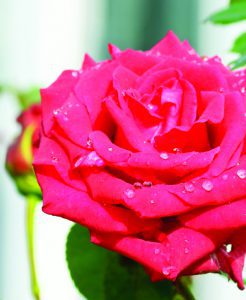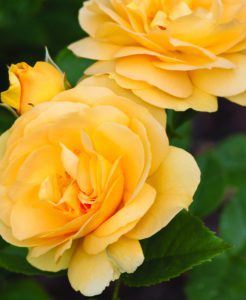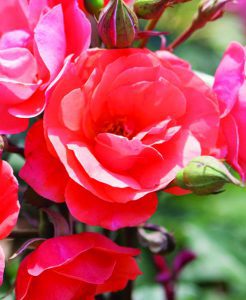 Our romance with the Rose goes back thousands of years. Symbols of love and beauty, they have become a favorite plant of gardeners around the world. At times considered difficult to grow, roses today exhibit greater flower production, improved disease resistance and beautiful fragrance. They come in sizes and shapes to suit any landscape purpose, whether that be a formal rose garden, part of a mixed border, twining up a trellis, or showing off in a container.
Our romance with the Rose goes back thousands of years. Symbols of love and beauty, they have become a favorite plant of gardeners around the world. At times considered difficult to grow, roses today exhibit greater flower production, improved disease resistance and beautiful fragrance. They come in sizes and shapes to suit any landscape purpose, whether that be a formal rose garden, part of a mixed border, twining up a trellis, or showing off in a container.
The diversity of roses is simply astonishing. With a long history dating back centuries, roses have undergone many transformations to be the beautiful blooms we enjoy today. Breeding efforts in recent years have combined the virtues of the old garden roses with the modern rose classes, resulting in the myriad of beautiful and easier-to-care for choices we enjoy today!
CARE & MAINTENANCE
To perform their best, roses prefer a full sun location, meaning 6 or more hours of sunlight each day. They need a soil rich in organic matter, and consistent and regular watering. Roses are heavy feeders and a monthly feeding with an organic fertilizer such as Rose-Tone will provide the necessary nutrients to ensure the largest number of flowers. Roses should be fertilized from May until the first of September. As fall approaches, stop fertilizing as you do not want to encourage new growth which may not have time to harden off before the cold weather arrives.
Pruning need not be difficult or intimidating. In very early spring as the leaf buds are beginning to swell, use a sharp pair of hand pruners to remove dead and crossing canes. The rule of thumb is to shorten the canes by one-third, but if you want to reduce or contain the overall size of the rose, now is the time to cut it back hard. Make your cut a half inch above an outward facing bud. This will direct new growth to the outside of the plant rather than into the center, allowing sunlight and air into the center of the plant.
During the season, spent blooms should be removed, again with clean and sharp hand pruners, to encourage further flower development. For many years it was thought that you had to cut above a five-leaflet compound leaf but this is now proven to be unnecessary. Simply prune back to the next leaf break, regardless of how many leaflets there are.
Many roses appreciate winter protection to keep them uniformly cold all winter, preventing the damaging effects of alternate freezing and thawing. Wait until a hard frost has caused most of the leaves to fall and even until the temperature has dropped into the teens for several nights. Remove any foliage or other debris on the ground that might harbor disease for the next season. Prune long canes that might whip in the wind but in general, pruning at this point should be kept to a minimum.

 Hybrid Tea Roses are excellent garden plants suitable for cutting, single plantings, or in mixed beds with other perennials, shrubs and roses. With large, well-formed blooms and upright, sturdy canes, they are most popular as cut flowers. Grandiflora Roses are similar to Hybrid Teas in habit and size. They generally are tall plants that present their blooms in clusters, rather than as one-per-stem. They make excellent garden plants and are also very popular as cut flowers. Look for varieties like ‘Mister Lincoln’ a favorite tea rose of many gardeners for decades! With rich maroon buds that open to velvet red petals, Mister Lincoln roses are perfect for cutting. Blooms from early summer to mid-fall. Another hybrid tea favorite? Pope John Paul II, one of the most beautiful white roses ever. With large 5″+ blooms and incredible fragrance, it’s no wonder why it is to this day a showpiece in the Vatican private garden.
Hybrid Tea Roses are excellent garden plants suitable for cutting, single plantings, or in mixed beds with other perennials, shrubs and roses. With large, well-formed blooms and upright, sturdy canes, they are most popular as cut flowers. Grandiflora Roses are similar to Hybrid Teas in habit and size. They generally are tall plants that present their blooms in clusters, rather than as one-per-stem. They make excellent garden plants and are also very popular as cut flowers. Look for varieties like ‘Mister Lincoln’ a favorite tea rose of many gardeners for decades! With rich maroon buds that open to velvet red petals, Mister Lincoln roses are perfect for cutting. Blooms from early summer to mid-fall. Another hybrid tea favorite? Pope John Paul II, one of the most beautiful white roses ever. With large 5″+ blooms and incredible fragrance, it’s no wonder why it is to this day a showpiece in the Vatican private garden. are hardy, free flowering, bushy and dense in form. They generally grow 2’-5’ tall making them useful for hedging. They produce large sprays of single, semi-double or double flowers, depending on the variety, throughout the growing season. Their foliage is generally glossy and disease resistant. ‘Julia Child’ has full buttery yellow blooms from June through the fall. This rose has a pleasant licorice-clove fragrance that its namesake would have loved in the kitchen.
are hardy, free flowering, bushy and dense in form. They generally grow 2’-5’ tall making them useful for hedging. They produce large sprays of single, semi-double or double flowers, depending on the variety, throughout the growing season. Their foliage is generally glossy and disease resistant. ‘Julia Child’ has full buttery yellow blooms from June through the fall. This rose has a pleasant licorice-clove fragrance that its namesake would have loved in the kitchen. This term covers a number of categories and series. The heavy flowering display and easy care nature of these roses has been credited with the recent resurgence and interest in roses. The popularity of the Knock Out® series of roses is due to their easy care and disease resistant nature. They are available in single or double flowering varieties in pink, red, peach, yellow white, and now coral varieties. Faded flowers drop from the plant without the need for deadheading. Repeat flowering occurs on its own but will be enhanced with an application of organic rose fertilizer after each successive bloom cycle.
This term covers a number of categories and series. The heavy flowering display and easy care nature of these roses has been credited with the recent resurgence and interest in roses. The popularity of the Knock Out® series of roses is due to their easy care and disease resistant nature. They are available in single or double flowering varieties in pink, red, peach, yellow white, and now coral varieties. Faded flowers drop from the plant without the need for deadheading. Repeat flowering occurs on its own but will be enhanced with an application of organic rose fertilizer after each successive bloom cycle.